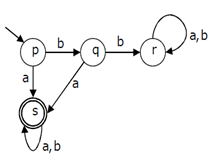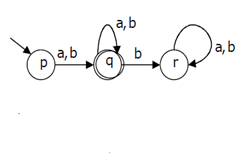Can a DFA simulate NDFA?
Find the wrong statement?
Regular expression a/b denotes which of the following set?
Which behaviour of a NFA can be stimulated by DFA?
For any DFA state {qi,qj…qm} If some qj is a final state in the NFA Then {qi,qj…qm}, is a final state in the DFA.
What is the relation between NFA-accepted languages and DFA accepted languages?
In regular expressions, the operator ‘*’ stands for?
A deterministic finite automation (DFA)D with alphabet ∑ = {a,b} is given below. Which of the following is a valid minimal DFA which accepts the same language as D?
The lexical analysis for a modern language such as Java needs the power of which one of the following machine models in a necessary and sufficient sense?
Is empty string a valid input in Ndfa.


_1630842349.png)

